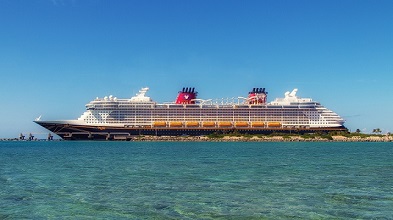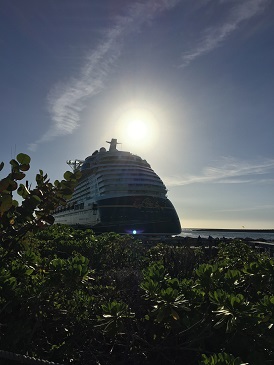NATIONAL REPORT—Every year, millions of people on vacation opt for cruise travel to relax, explore new ports of call and partake in a host of fun activities, fine food and fancy umbrella drinks. Yet cruise ships have a huge negative impact on the world’s oceans. Today’s ocean vessels produce a ton of waste, and traditionally, little of it was recycled.
Additionally, cruise ships produce a ton of organic waste and sewage, most of which previously expelled directly into ocean waters. Leftover foods which could feed the hungry were tossed, and few if any dining materials such as plastic straws, plates, etc. saw the recycling bin. Due to the increasing threat of global catastrophe from unmitigated pollution and unchecked climate change, many cruise lines now institute more sustainable practices to protect the planet we all share.
What Is Green Cruising and Sustainable Travel?

Sustainable travel refers to tourism which aims to protect the natural and cultural environment of the region visited. Part of sustainable tourism involves protecting the native flora and fauna of a region by minimizing habitat destruction and leaving only footprints. It also consists of respecting the native culture of the region and interacting conscientiously with the area’s inhabitants, part of which, of course, is protecting the resources they rely upon for survival.
When it comes to cruising, going more green means eliminating the major sources of pollution from ships. And this waste far exceeds the amount produced on land. One recent study estimated an individual who takes a seven-day cruise creates as much waste as they would during 18 days on land. Pollution nearly triples the minute someone steps on board a boat.
Major sources of pollution from cruise ships involve the following:
- Fuel oil: Back in the days of the Titanic, many ocean cruise liners used coal to fire their engines. Today, most cruise ships rely primarily upon diesel fuel, which, despite advances to make it cleaner burning, is heavier and oilier than gasoline. One 2017 study suggested cruise ships produce the emissions of one million cars daily, an estimate which boggles the mind given the reality of climate change.
- Sewage: Ever wonder what happens when someone flushes a toilet on a cruise ship? While both the Environmental Protection Agency and international treaties exist governing the disposal of liquid and solid human waste, the fact remains cruise ships release tons of gray water, basically, treated sewage, into our oceans each year.
- Organic and inorganic garbage waste: Those delicious meals the ship’s chef team whips up results in a good deal of organic waste. Straw wrappers, straws, plastic dining ware and glasses, soda and juice bottles and trash bags also all get discarded. In previous years, few if any of these items were recycled.
- Ecological damage: Today’s cruise ships are bigger than ever, which results in greater environmental damage. Dredging destroys native ocean plants and habitats to allow for ship passage. When habitats are destroyed, the animals which rely upon them also perish.
Harnessing the Power of the Wind & Sun
One measure several cruise lines take to address the problem of the vast amounts of fuel cruise ships use daily revolves around alternative sources of power. For example, Windstar Cruise Lines has designed a line of “smart yachts” which harness the power of the wind to help propel the vessel without running the engines full tilt at all times. The move hearkens back to the days when ships would billow their sails to propel themselves across the ocean, only while retaining the ability to use engine power when necessary. And watching today’s huge sails unfurl offers unparalleled romantic ambiance as well as saving fuel.
Another technology intended to curtail the amount of diesel cruise ships use is solar power. Japanese shipbuilder Peace Boat is currently designing a line of solar-powered ships with expansive panels on top. The $500 million Ecoship is intended to utilize 30 percent less carbon dioxide, 20 percent less propulsion energy and 50 percent less electricity. The boat will also feature a rooftop organic garden to produce food for the ship’s kitchens.
Dealing with the Problem of Raw Sewage

People have the biological need to use the loo, especially when overindulging in food and drink as many vacationers do. And ships may remain at sea for weeks, even months, at a time, producing a ton of sewage waste.
Cruise ships are bound by both U.S. federal law and international treaty regulations to manage cruise ship waste in a certain manner. Each ship must have a dedicated officer to oversee the treatment of liquid and solid waste. While the treated water still primarily expels into the ocean, technologies are under development to find environmentally-friendly methods to transform this waste into fuel.
Switching to Eco-Friendly Materials
Plastic waste has reached epidemic levels. Researchers discovered plastic waste in 60 percent of the world’s seabirds and, shockingly, 100 percent of the world’s sea turtle population. Every year, an additional 8 million metric tons of plastic waste gets added to the 150 million already circulating in the world’s waterways, and some scientists fear the oceans may soon contain more plastic than fish per pound.
To address this problem, cruise lines take measures to reduce or eliminate plastic waste. MSC Cruises pledged to eliminate single-use plastics and accomplished this goal in March of 2019. Other major cruise lines eliminating plastic straw use include Royal Caribbean, Carnival and Norwegian Cruise lines. Many of these vessels and others are likewise instituting onboard recycling programs to improve sustainability further.
Reducing Dredging and Protecting Wildlife
Today’s cruise ships dwarf those of yesteryear, and to dock at port travel companies dredge deep channels to allow ships to reach the shore so passengers can board and depart. Doing so causes incredible devastation to native wildlife, including coral reefs. A battle currently rages in Key West over plans to dredge a deep channel which may impact reef life around the Florida Keys.
Other nations have taken measures to protect their native ocean habitats. Venice, Italy, for example, recently announced plans to reroute a channel around the center city to protect the Venice lagoon.
Another solution to dredging would be returning to earlier days when smaller skiffs transported passengers from shore to larger vessels. While this may cause consternation to passengers who experience seasickness on smaller vessels, preserving native habitats should take precedence whenever possible.
Making Cruising More Sustainable
Given the popularity of cruises among travelers, it’s unlikely the industry will disappear anytime soon. People have long craved sailing the seven seas. However, by switching to more sustainable practices, cruise lines can minimize their environmental impact while still providing passengers a one-of-a-kind vacation experience.
Kacey Bradley is the blogger behind The Drifter Collective, an eclectic lifestyle blog that expresses various forms of style through the influence of culture and the world around us. Along with writing for her blog, she has written for sites like U.S. News, SUCCESS, Guides for Brides, Hotel Online and more. Follow Kacey on Twitter and subscribe to her blog to keep up with her travels and inspiring posts.






